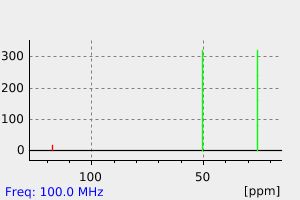1-氰基吡咯烷 | 1530-88-7
中文名称
1-氰基吡咯烷
中文别名
吡咯烷-1-甲腈
英文名称
pyrrolidine-1-carbonitrile
英文别名
1-pyrrolidine carbonitrile;1-cyanopyrrolidine;N-cyanopyrrolidine;pyrrolidine carbonitrile
CAS
1530-88-7
化学式
C5H8N2
mdl
——
分子量
96.1319
InChiKey
QJRYYOWARFCJQZ-UHFFFAOYSA-N
BEILSTEIN
——
EINECS
——
-
物化性质
-
计算性质
-
ADMET
-
安全信息
-
SDS
-
制备方法与用途
-
上下游信息
-
文献信息
-
表征谱图
-
同类化合物
-
相关功能分类
-
相关结构分类
物化性质
-
沸点:75-77 °C1.8 mm Hg(lit.)
-
密度:0.954 g/mL at 25 °C(lit.)
-
闪点:225 °F
计算性质
-
辛醇/水分配系数(LogP):1
-
重原子数:7
-
可旋转键数:0
-
环数:1.0
-
sp3杂化的碳原子比例:0.8
-
拓扑面积:27
-
氢给体数:0
-
氢受体数:2
安全信息
-
危险等级:6.1
-
危险品标志:Xn
-
危险类别码:R20/21/22
-
危险品运输编号:UN 3276
-
WGK Germany:3
-
海关编码:2933990090
-
包装等级:III
-
危险类别:6.1
-
安全说明:S28,S36/37
-
危险性防范说明:P501,P261,P270,P271,P264,P280,P337+P313,P305+P351+P338,P332+P313,P362,P301+P310+P330,P302+P352+P312,P304+P340+P311,P403+P233,P405
-
危险性描述:H301+H311+H331,H315,H319
-
储存条件:存储条件:0-10°C,需置于惰性气体中,避免与空气接触及加热。
SDS
反应信息
-
作为反应物:描述:1-氰基吡咯烷 在 氢气 、 sodium carbonate 、 1,8-二氮杂双环[5.4.0]十一碳-7-烯 、 N,N'-羰基二咪唑 、 sodium hydroxide 、 三氯氧磷 作用下, 以 四氢呋喃 、 1,4-二氧六环 、 N-甲基吡咯烷酮 、 甲醇 、 乙醇 、 水 为溶剂, 反应 14.83h, 生成 4-methoxy-6,7-dimethyl-2-(2-(1-methyl-3-(pyrrolidin-1-yl)-1H-1,2,4-triazol-5-yl)ethyl)imidazo[2,1-f][1,2,4]triazine参考文献:名称:[EN] TRIAZOLO COMPOUNDS
[FR] COMPOSÉS TRIAZOLO摘要:本发明涉及式(I)的化合物及其在治疗神经系统疾病中的应用。公开号:WO2014072261A1 -
作为产物:描述:参考文献:名称:Schroth, W.; Kluge, H.; Frach, R., Journal fur praktische Chemie (Leipzig 1954), 1983, vol. 325, # 5, p. 787 - 802摘要:DOI:
-
作为试剂:参考文献:名称:双(吡啶酮)锆:一种修饰的酰胺化物配合物,可增强氨基烯烃环氢胺化中的底物范围†摘要:一个新的 双(氨基)锆双(氨基) 加氢胺化前催化剂的使用 6-叔丁基-3-苯基-2-吡啶酮作为配位体已经被制备和表征。已发现这种早期过渡金属配合物的罕见例子,该配合物含有2-吡啶酮衍生物作为辅助配体,可有效地进行氨基烯烃的环加氢氨基化反应,包括更具挑战性的带有未活化内部C C键的底物。DOI:10.1039/b913393c
文献信息
-
Catalytic hydration of cyanamides with phosphinous acid-based ruthenium(<scp>ii</scp>) and osmium(<scp>ii</scp>) complexes: scope and mechanistic insights作者:Rebeca González-Fernández、Daniel Álvarez、Pascale Crochet、Victorio Cadierno、M. Isabel Menéndez、Ramón LópezDOI:10.1039/d0cy00523a日期:——phosphinous acid-based complexes [MCl2(η6-p-cymene)(PMe2OH)] (M = Ru (1), Os (2)) as catalysts. The reactions proceeded cleanly under mild conditions (40–70 °C), in the absence of any additive, employing low metal loadings (1 mol%) and water as the sole solvent. In almost all the cases, the osmium complex 2 featured a superior reactivity in comparison to that of its ruthenium counterpart 1. In addition通过使用水合相应的氰胺R 1 R 2 NC N成功地完成了多种脲R 1 R 2 NC(O)NH 2的合成(R 1和R 2 =烷基,芳基或H; 26个实例)的三价膦酸基配合物[的MC1 2(η 6 - p -cymene)(PME 2 OH)](M =茹(1),锇(2))作为催化剂。反应在温和的条件下(40-70°C)干净进行,没有任何添加剂,使用低金属负载量(1 mol%)和水作为唯一溶剂。在几乎所有情况下,complex配合物2的反应活性都比钌配合物1高。另外,对于两种催化剂,氰酰胺底物水合所观察到的反应速率明显快于涉及传统脂族和芳族腈的反应速率。计算研究使我们能够合理化所有这些趋势。因此,计算表明存在直接与碳原子相连的氮原子当与金属中心配位时,N键通过感应效应使腈碳电子减少,从而促进次膦酸配体的OH基团对该碳的分子内亲核攻击。另一方面,Os对Ru的较高反应性似乎与初始金属环上较低的环应
-
Isoform-Selective Substrates of Nitric Oxide Synthase作者:Qiang Jia、Tingwei Cai、Mingchuan Huang、Huiying Li、Ming Xian、Thomas L. Poulos、Peng G. WangDOI:10.1021/jm0340703日期:2003.6.1Because of the double-edged nature of NO, the development of isoform-selective NOS substrates is a highly desirable goal. Given the striking similarity in the heme active sites of the three NOS isoforms, it presents an challenging problem. Several N-aryl-N'-hydroxyguanidines have recently been shown as substrates that are selective for iNOS over nNOS. Here, we report the first success that 3 is a good由于NO的双重优势,开发同工型选择性NOS底物是一个非常理想的目标。鉴于三种NOS亚型的血红素活性位点具有惊人的相似性,因此提出了一个具有挑战性的问题。最近已显示出几种N-芳基-N'-羟基胍作为对iNOS的选择性底物,而不是对nNOS的底物。在这里,我们报告的第一个成功是3是iNOS的nNOS(70%的NOHA活性,K(m)约为40 +/- 6 microM)的良好底物。
-
Hepatitis C virus inhibitors申请人:BRISTOL-MYERS SQUIBB COMPANY公开号:US09527885B2公开(公告)日:2016-12-27Hepatitis C virus inhibitors having the general formula (I) are disclosed. Compositions comprising the compounds and methods for using the compounds to inhibit HCV are also disclosed.揭示了具有一般式(I)的丙型肝炎病毒抑制剂。还公开了包含这些化合物的组合物以及使用这些化合物抑制HCV的方法。
-
A Serendipitous Discovery: Nickel Catalyst for the Cycloaddition of Diynes with Unactivated Nitriles作者:Puneet Kumar、Simon Prescher、Janis LouieDOI:10.1002/anie.201104475日期:2011.11.49‐dimethylxanthene (Xantphos) was used to access pyridines (see scheme). The reaction proceeds under ambient conditions to provide excellent yields of the products. Comparison of this catalyst with the other state‐of‐the‐art catalysts is also provided.
-
Ruthenium-Catalyzed [2 + 2 + 2] Cycloaddition Reaction Forming 2-Aminopyridine Derivatives from α,ω-Diynes and Cyanamides作者:Fei Ye、Mansour Haddad、Virginie Ratovelomanana-Vidal、Véronique MicheletDOI:10.1021/acs.orglett.7b00130日期:2017.3.3A novel, efficient, and mild synthetic route for the preparation of 2-aminopyridines via ruthenium-mediated [2 + 2 + 2] cycloaddition of α,ω-diynes and cyanamides has been developed. This atom-economical catalytic process demonstrated remarkable regioselectivities to access pyridine derivatives of high synthetic utility.
表征谱图
-
氢谱1HNMR
-
质谱MS
-
碳谱13CNMR
-
红外IR
-
拉曼Raman
-
峰位数据
-
峰位匹配
-
表征信息
同类化合物
(5R,Z)-3-(羟基((1R,2S,6S,8aS)-1,3,6-三甲基-2-((E)-prop-1-en-1-yl)-1,2,4a,5,6,7,8,8a-八氢萘-1-基)亚甲基)-5-(羟甲基)-1-甲基吡咯烷-2,4-二酮
(2R,2''R)-(-)-2,2''-联吡咯烷
麦角甾-7,22-二烯-3-基亚油酸酯
马来酰亚胺霉素
马来酰亚胺基酰肼盐酸盐
马来酰亚胺基甲基-3-马来酰亚胺基丙酸酯
马来酰亚胺丙酰基-dPEG4-NHS
马来酰亚胺-酰胺-PEG6-琥珀酰亚胺酯
马来酰亚胺-酰胺-PEG6-丙酸
马来酰亚胺-酰胺-PEG24-丙酸
马来酰亚胺-酰胺-PEG12-丙酸
马来酰亚胺-四聚乙二醇-羧酸
马来酰亚胺-四聚乙二醇-丙酸叔丁酯
马来酰亚胺-四聚乙二醇-丙烯酸琥珀酰亚胺酯
马来酰亚胺-六聚乙二醇-羧酸
马来酰亚胺-六聚乙二醇-丙酸叔丁酯
马来酰亚胺-八聚乙二醇-丙酸叔丁酯
马来酰亚胺-二聚乙二醇-丙酸叔丁酯
马来酰亚胺-三(乙烯乙二醇)-丙酸
马来酰亚胺-一聚乙二醇-羧酸
马来酰亚胺-一聚乙二醇-丙烯酸琥珀酰亚胺酯
马来酰亚胺-PEG3-羟基
马来酰亚胺-PEG2-胺三氟醋酸盐
马来酰亚胺-PEG2-琥珀酰亚胺酯
马来酰亚胺
频哪醇硼酸酯
顺式草酸双(-3,8-二氮杂双环[4.2.0]辛烷-8-羧酸叔丁酯)
顺式4-甲基吡咯烷酮-3-醇盐酸盐
顺式4-氟吡咯烷酮-3-醇盐酸盐
顺式3,4-二羟基吡咯烷盐酸盐
顺式3,4-二氨基吡咯烷-1-羧酸叔丁酯
顺式-二甲基 1-苄基吡咯烷-3,4-二羧酸
顺式-N-[2-(2,6-二甲基-1-哌啶基)乙基]-2-氧代-4-苯基-1-吡咯烷乙酰胺
顺式-N-Boc-吡咯烷-3,4-二羧酸
顺式-5-苄基-2-叔丁氧羰基六氢吡咯并[3,4-c]吡咯
顺式-5-甲基-1H-六氢吡咯并[3,4-b]吡咯二盐酸盐
顺式-5-氧代六氢环戊二烯并[c]吡咯-2(1H)-羧酸叔丁酯
顺式-5-乙氧羰基-1H-六氢吡咯并[3,4-B]吡咯盐酸盐
顺式-5-(碘甲基)-4-苯基-2-吡咯烷酮
顺式-5-(碘甲基)-4-甲基-2-吡咯烷酮
顺式-4-氧代-六氢-吡咯并[3,4-C]吡咯-2-甲酸叔丁酯
顺式-3-氟-4-羟基吡咯烷-1-羧酸叔丁酯
顺式-3-氟-4-甲基吡咯烷盐酸盐
顺式-2-甲基六氢吡咯并[3,4-c]吡咯
顺式-2,5-二甲基吡咯烷
顺式-1-苄基-3,4-吡咯烷二甲酸二乙酯
顺式-1-甲基六氢吡咯并[3,4-b]吡咯
顺式-(9CI)-3,4-二乙烯-1-(三氟乙酰基)-吡咯烷
顺-八氢环戊[c]吡咯-5-酮盐酸盐
非星匹宁









